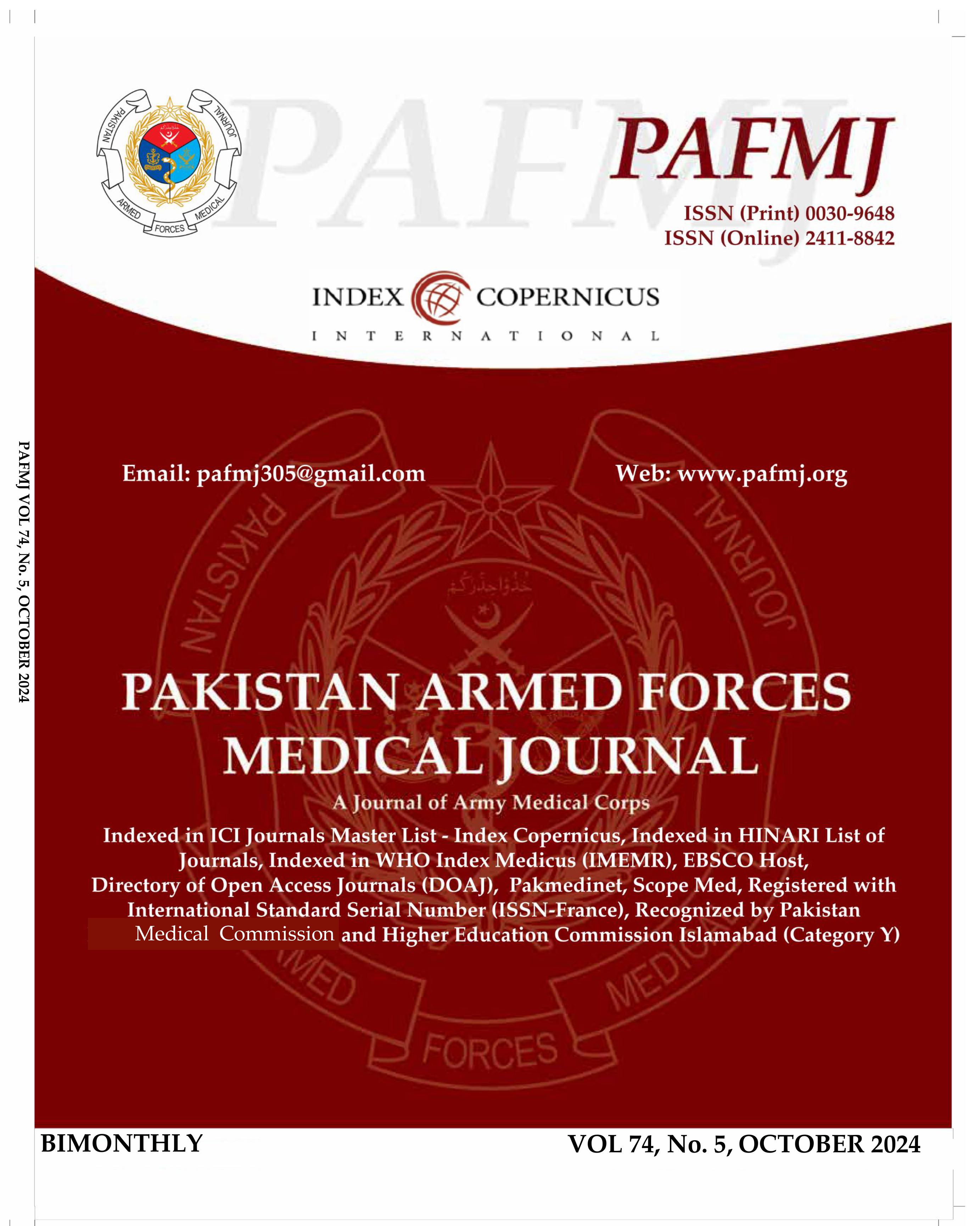Influence of Age, Gender and BMI on Normal Abdominal Aorta Diameter taken on Abdominal Sonography in Healthy Asymptomatic Pakistani Population
DOI:
https://doi.org/10.51253/pafmj.v74i5.8527Keywords:
Abdominal aorta diameter, Abdominal aorta aneurysm, Anteroposterior diameter, Transverse diameter, Ultrasonography.Abstract
Objective: To evaluate the abdominal aorta diameter in asymptomatic Pakistani population to determine the associations between age, gender and BMI and abdominal aortic diameter measured by ultrasonography.
Study Design: Case series.
Place and Duration of Study: Department of Radiology, Combined Military Hospital, Lahore, Pakistan, from Jun to Dec 2021.
Methodology: A total of ninety-four healthy asymptomatic subjects of both genders, between 18-80 years of age, were enrolled for the study. Aortic diameters were measured (inner to inner method) using electronic calipers on static images. The Anteroposterior and Transverse (TR) diameters were measured at three levels: the first at the aortic hiatus, which was directly below the abdominal aortic commencement, the second at the suprarenal (mid-point), and the third at the aortic bifurcation (lower level).
Results: Males had significantly larger (p-value<0.001) anteroposterior and transverse abdominal aorta diameters than females, with abdominal aorta diameter values found to be significantly higher (p-value 0.001) in age group of greater than 40 years except anteroposterior distal abdominal aorta diameter. Similarly, a significant difference (p-value <0.001) was noted in abdominal aorta diameter among patients with different BMI groups other than distal abdominal aorta diameter.
Conclusion: Abdominal aorta diameters vary greatly depending on age, gender and BMI. Clinicians must know the usual diameter of the abdominal aorta in order to recognize an aneurysm at an early stage.
Downloads
References
Hussain AY, Dakpa T, Fardous M, Melo F, Matinez F. Role of ultrasound in the diagnosis of abdominal aortic aneurysm. EC Cardiol 2018; 5: 955-968.
Wemmelund H. Abdominal Aortic Aneurysms Pharmaco-epidemiological Studies. Dan Med J 2017; 64: 01-26.
Zommorodi S, Leander K, Roy J, Steuer J, Hultgren R. Understanding abdominal aortic aneurysm epidemiology: Socioeconomic position affects outcome. J Epidemiol Community Health 2018;72: 904-910.
https://doi.org/10.1136/jech-2018-210644
Aggarwal S, Qamar A, Sharma V, Sharma A. Abdominal aortic aneurysm: a comprehensive review. Exp Clin Cardiol 2011; 16: 11-15.
Stackelberg O, Bjorck M, Larsson SC, Orsini N, Wolk A. Sex differences in the association between smoking and abdominal aortic aneurysm. Br J Surg 2014; 101(2): 1230-1237.
Stoberock K, Rieb HC, Debus ES, Schwaneberg T, Kölbel T, Behrendt C. Gender differences in abdominal aortic aneurysms in Germany using health insurance claims data. Vasa 2018; 47: 36-42. https://doi.org/10.1024/0301-1526/a000665
Takagi H, Umemoto T. The association between body mass index and abdominal aortic aneurysm growth: a systematic review. Vasa 2016; 45(1): 119-124.
https://doi.org/10.1024/0301-1526/a000505
Liang TW, Wang SK, Dimusto PD, McAninch CM, Acher CW, Timsina LR, et al. Association between body mass index and perioperative mortality after repair of ruptured abdominal aortic aneurysms. J Vasc Endovasc Surg 2020; 54: 573-578.
https://doi.org/10.1177/1538574420939356
Lo RC, Schermerhorn ML. Abdominal aortic aneurysms in women. J Vasc Surg 2016; 63: 839-844.
Sisó-Almirall A, Kostov B, González MN, Salami DC, Jiménez AP, Solé RG, et al. Abdominal aortic aneurysm screening program using hand-held ultrasound in primary healthcare. PLoS ONE 2017; 12(1): 1-16.
https://doi.org/10.1371/journal.pone.0186427
Joh JH, Ahn HJ, Park HC. Reference diameters of the abdominal aorta and iliac arteries in the Korean population. Yonsei Med J 2013; 54(1): 48-54. https://doi.org/10.3349/ymj.2013.54.1.48
Usman BO, Ibinaiye PO, Abdulaziz U, Inah GB. The relationship between infrarenal and suprarenal transverse aortic diameter on ultrasound among adults in Zaria, Nigeria. Arch Int Surg 2015; 5: 137-142.
https://doi.org/10.4103/2278-9596.169842
Gameraddin M. Normal abdominal aorta diameter on abdominal sonography in healthy asymptomatic adults: impact of age and gender. J Radiat Res Appl Sci 2019; 12: 186-191.
https://doi.org/10.1080/16878507.2019.1627019
Okpaleke MS, Ikamaise VC, Ogolodom MP, Agbo J, Mbaba AN. Sonographic reference luminal diameter of the abdominal aorta among subjects in Nigeria. Health Sci J 2020; 5:1-5.
Norman PE, Muller J, Golledge J. The cardiovascular and prognostic significance of the infrarenal aortic diameter. J Vasc Surg 2011; 54(1): 1817-1820.
https://doi.org/10.1016/j.jvs.2011.06.110
Sariosmanoglu N, Ugurlu B, Karacelik M, Tuzun E, Yorulmaz I, Manisali M, et al. A multicentre study of abdominal aorta diameters in a Turkish population. J Int Med Res 2002; 30: 1-8.
https://doi.org/10.1177/147323000203000101
Da Silva ES, Rodrigues AJ Jr, Castro de Tolosa EM, Bueno Pereira PR, Zanoto A, Martins J. Variation of infrarenal aortic diameter: a necropsy study. J Vasc Surg 1999; 29: 920-927.
https://doi.org/10.1016/S0741-5214(99)70211-0
Wanhainen A, Themudo R, Ahlström H, Lind L, Johansson L. Thoracic and abdominal aortic dimension in 70-year-old men and women--a population-based whole-body magnetic resonance imaging (MRI) study. J Vasc Surg 2008; 47: 504-512.
https://doi.org/10.1016/j.jvs.2007.11.049
Esposito R, Ilardi F, Schiano Lomoriello V, et al. Identification of the main determinants of abdominal aorta size: a screening by Pocket Size Imaging Device. Cardiovasc Ultrasound 2017; 15: 2-4.
https://doi.org/10.1186/s12947-017-0100-2
Valecchi D, Bacci D, Guilisano M, Sgambati E, Sibilio M, Lipoma M, et al. Assessment of internal diameters of abdominal and femoral blood vessels in 250 living subjects using colour Doppler ultrasonography. Ital J Anat Embryol 2010; 115: 180-184
Downloads
Published
Issue
Section
License
Copyright (c) 2024 Qurat-ul-Ain, Ammara Iftikhar, Tariq Mirza

This work is licensed under a Creative Commons Attribution-NonCommercial 4.0 International License.















